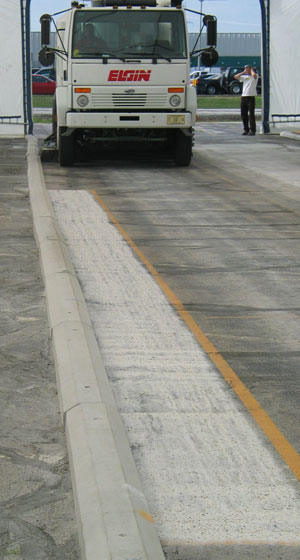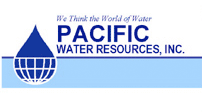Sweeper Test Results Highlight Positive Impact of Sweeping on Reducing Storm Water Pollution |
|
by Ranger Kidwell-Ross
Elgin Sweeper, the leading manufacturer of street sweepers in the United States, has released results of a sweeper test performed by an independent group of storm water control experts, headed by Roger Sutherland, president of Pacific Water Resources, Inc. The results demonstrate the efficiency of Elgin Sweeper street sweepers in removing storm water pollutants.

The sweeping industry has long been hampered by the mechanical sweeper studies held as part of the 1980s National Urban Runoff Protocol. Those results were mixed when it came to the ability of power sweeping to address storm water runoff pollution. More recently, the South Coast Air Quality Management District (AQMD) got involved with sweeper testing. The problem: The test was so easy that, to my knowledge, every model tested by every manufacturer eventually passed the pass/fail protocol. A test with no actual test results listed--and which all sweepers can pass--is, in many ways, worse than no test at all. What has occurred is that all sweeper manufacturers tout they are 'PM-10 Compliant,' as a result of passing the AQMD. This has been the case even though a passing grade was 70% pickup of debris and there was a PM-10 component of only 10% in the test material.
In July of 2008, Sutherland's company, Pacific Water Resources, Inc., conducted an independent test of four of Elgin's sweeper models. The tests were run without water for dust suppression, with the exception of the Eagle, which was tested both with and without use of dust suppression water sprays. The models were:
According to PWR's test results, Elgin Sweeper's prototype Crosswind NX (a high-performance filter regeneration sweeper with dust control) performed the best, removing 97.5 percent of the pollutants; the standard regenerative air Crosswind removed 96.4 percent of the pollutants; the vacuum Whirlwind MV removed 93.5 percent of the pollutants; and the mechanical Waterless Eagle FW removed 91.5 percent of the pollutants. The mechanical Waterless Eagle, when also tested with a water spray, removed 81.0 percent of the pollutants. The latter test supports the theory held by this author, as well as other industry watchers, that use of water for dust suppression creates a 'PM-10 slurry' that inhibits pickup of the smaller particles, those targeted both under the USEPA Clean Air Act and Clean Water Act. The sweeping industry has long been looking for a way to quantify repeatable effectiveness of sweepers on picking up street debris. Until now, without a viable test in the street sweeper marketplace, users of street sweepers have had to rely on unsubstantiated claims made by manufacturers, along with glossy brochures and anecdotal evidence from local testing. The Elgin test raises the bar in this regard, and it would appear will virtually force the other manufacturers to replicate the test on their own sweepers to keep pace. "In today's economy, everybody has to do more with fewer resources," said Brian Giles, sweeper products manager at Elgin Sweeper. "Municipalities are required to put best management practices in place to reduce storm water pollution, and many are using structural treatment devices like underground vaults and drain catch basin inserts that are expensive to install and maintain." However municipalities are spending their money, Giles emphasized the importance of getting a measurable return. "From the standpoint of dollars per pound of pollutant removed from the storm water, these test results confirm what we already knew that nothing comes close to matching the effectiveness of Elgin Sweeper street sweepers in removing storm water pollutants," Giles added. 
"Over the last 20 years, several tests have been conducted to try to determine if street sweepers reduce storm water pollution," Giles said. "A number of sweeper manufacturers are making claims about what their machines can do to reduce storm water pollution without any supporting data." Elgin Sweeper is to be applauded for making a significant investment in conducting an independent, credible, repeatable test to measure the sweeping efficiency of its sweepers. "Now we can provide our customers and the industry with solid, factual data on the efficiency of our sweepers in picking up street debris and removing storm water pollutants," Giles said. According to Giles, Elgin Sweeper wanted quantifiable results of what the storm water experts say about the performance of its street sweepers. The company sought out Roger Sutherland's company, Pacific Water Resources, Inc. (PWR), one of the most credible, recognized independent experts on storm water control in the United States. Sutherland is a senior water resources engineer with 30 years of professional engineering experience in drainage master planning, water quality management planning, riverine hydraulics, flood management and water quality facility design. The WorldSweeper.com website offers a number of other articles by Sutherland on the issue of sweepers and control of storm water runoff pollution. 
PWR has also developed a state-of-the art load estimation procedure called SIMPTM (simplified particulate transport model) that can quantify urban pollution loadings and accurately estimate optimum cleaning practices for streets and catch basins. Sutherland and his associates have developed and refined the software over a period of approximately 20 years. His company has used the SIMPTM modeling software on numerous occasions to predict pollutant loading and wash-off processes. The software is considered by many industry experts, including myself, to be the most credible storm water quality modeling package in the United States. Using modeling tools that accurately simulate the sediment accumulation and wash-off behaviors and their interaction with cleaning practices, Sutherland and PWR designed and implemented a series of controlled street dirt pick-up performance tests for the four Elgin Sweeper models. The purpose of the field test was to measure the efficiency of the Elgin Sweeper machines operating under conditions typically found throughout the United States. Not surprisingly, Giles said Elgin Sweeper encourages other sweeper manufacturers to take this independent test and see what results their sweepers achieve. "We would like the sweeper industry to consider making this a standard test to measure the efficiency of all sweepers on the market." As part of the field test, five controlled pick-up performance tests were conducted by PWR on the four Elgin Sweeper models over a three-day period at a curbed test track. Giles said the controlled street dirt accumulations were formulated to simulate average street dirt. Each test was based on initial street dirt accumulation of approximately 792 pounds per curb mile 7.5 pounds (3405 g) spread evenly over a 50-foot by 2-foot track. The street dirt loadings used for these tests were well within the range of both accumulated mass and particle size distributions (PSDs) observed as part of the Nationwide Urban Runoff Program conducted more than 20 years ago. The average forward sweeping speeds for these tests were specified at 5 mph and were measured from 4.7 to 5.1 mph. The use of water spray for dust suppression was not used in five of the six tests. One test with the Eagle Waterless FW sweeper was conducted with the use of water spray. The same unit was also tested without the use of water. Overall pick-up efficiency for each sweeper tested was computed as a percentage of the initial weight removed and was based on the weight of the remaining material collected after the sweeping operation, compared to the known weight of stimulant spread evenly among the test track. A sieve analysis was conducted by a certified third-party soils lab on each of the six remaining material samples collected after each test and on a single sample of the stimulant itself. The results of these analyses allowed PWR to estimate the overall pick-up efficiency of each sweeper test and the pick-up efficiencies for each of the eight particle size groups used in the sieve analysis. "Elgin Sweeper is committed to providing municipalities with environmental solutions that reduce storm water and air pollution," Giles said. "From our alternative fuel-powered sweepers and waterless dust control sweepers, to our regenerative filtration systems, Elgin Sweeper is a technology leader in developing innovative products that result in cleaner streets, water and air."
Note: If you hear the interviews at 'chipmunk speed,' you will need to download the latest version of Adobe's free Flash player. No files will download to your computer. Note: To play the interview, click this link or on the small triangle inside the circle you see to the left. If you have any trouble accessing this audio, please let us know.Since this article was published, Pacific Water Resources, Inc. has merged with AMEC Earth & Environmental, Inc., a worldwide engineering consulting firm specializing in the fields of hydraulics, hydrology, water quality modeling and evaluation, fluvial geomorphology, sediment transport, and computer-aided mapping. Recognized as a leader in watershed management planning and design, PWR's technical expertise has been at the forefront of every major regulatory and technical advancement for assessing, enhancing and protecting water resources since 1978. For more company information, or to learn more about the SIMPTM test procedure, Roger Sutherland may be reached by calling (503) 639-3400, or via email sent to Roger.Sutherland@amec.com. To learn more about Elgin Sweeper company, and its now-leading industry role in reducing air and storm water pollution, go to www.elginsweeper.com/airandwater. For additional information on Elgin Sweeper's line of sweepers or to schedule a demonstration, please visit www.elginsweeper.com or see your local Elgin Sweeper dealer. Elgin Sweeper is a subsidiary of Federal Signal Corporation's Environmental Solutions Group.
|
© 2005 - 2021 World Sweeper
|
Street Contents
|